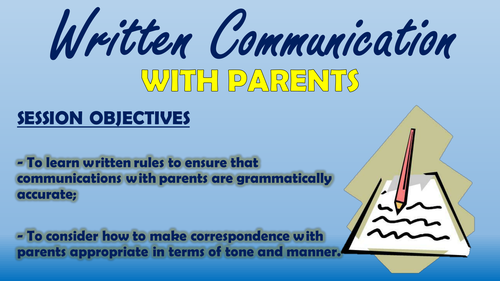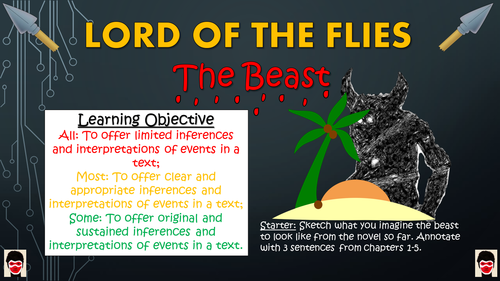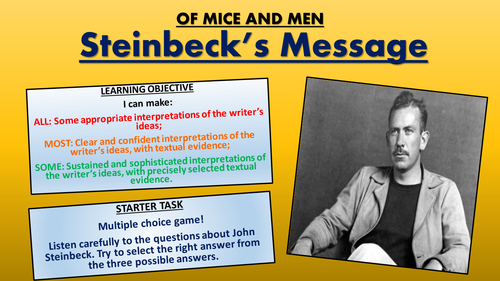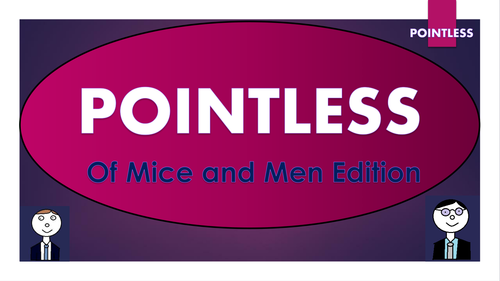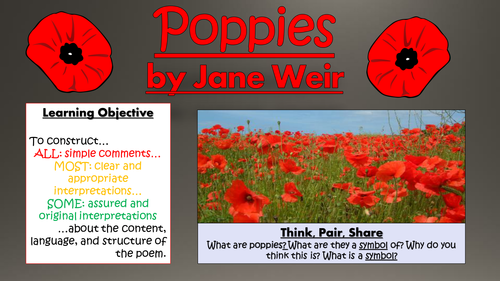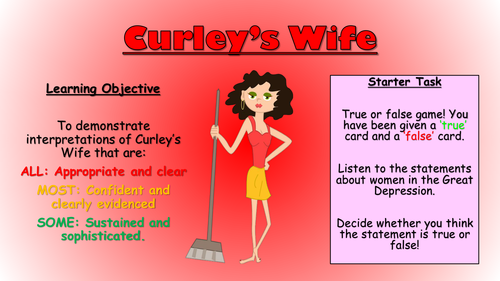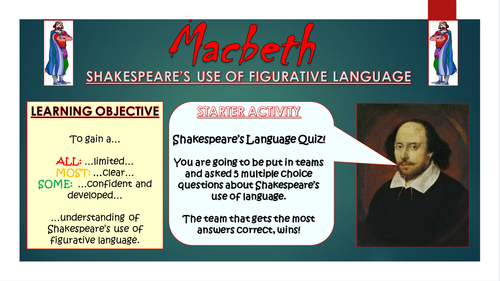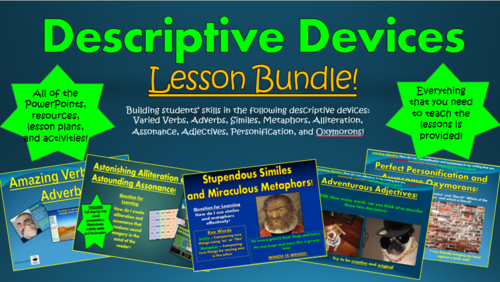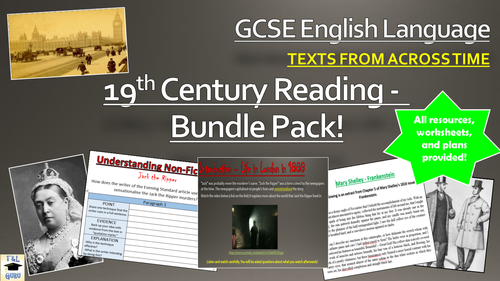
3k+Uploads
1889k+Views
2227k+Downloads
Pedagogy and professional development

Of Mice and Men - The Themes of Dreams and Loneliness
This engaging and interesting lesson aims to improve students' knowledge of the main themes (Dreams and Loneliness) in John Steinbeck's Of Mice and Men. It also aims to build their skills in retrieving information from texts, understanding the writer's ideas and opinions, and making precise and confident interpretations about texts.
The lesson uses a range of tasks, that require students to use their visual and interactive skills. It follows this learning journey:
- Understanding what dreams and loneliness are, and how we each experience them;
- Defining themes and understanding how writers use them;
- Understanding how and why themes are used in other famous texts;
- Retrieving evidence from the text to demonstrate where the characters experience dreams and loneliness;
- Analysing how the themes are used to help get across John Steinbeck's ideas about 1930s America;
- Evaluating each others' analytical attempts.
The resource includes a comprehensive and visually engaging PowerPoint presentation, a worksheet for recording the retrieved quotations, a helpful template for the main task, and a lesson plan/ teacher guidance sheet.
All images in this resource are licensed for commercial use, and are cited on the final slide of the lesson presentation.
You can choose to buy this resource alone, or as part of the 'Of Mice and Men - All Lessons and Scheme' bundle, which contains seven full lessons, resources, teachers notes, and PowerPoint presentations, plus a Pointless Of Mice and Men game, for just £5!

Written Communication with Parents - CPD Session!
I delivered this CPD session to all members of our staff team who maintain regular contact with parents and other stakeholders, in a bid to improve the quality, accuracy, and clarity of our written communications. I'd recommend that the session takes about 1 hour to 1 hour 30 minutes to deliver.
We had received some negative feedback comments, regarding our communications, varying from examples of poor grammatical accuracy, to instances in which the tone of emails, letters, and other forms of correspondence were perceived as rude. It is surprising how common this is across schools, and how little training is provided on these forms of interaction. Following this training, we are receiving far fewer complaints, and many staff members now keep the help-sheets pinned up by the desks to refer to when communicating with parents.
Participants learn through:
- Participating in a fun pub-style quiz to eradicate common spelling, punctuation, and grammar misconceptions and errors;
- Considering the role of parents, their needs and interests, and what they expect from their child's school, as a means to understand why schools sometimes receive difficult communications;
- Reading and analysing examples of poor written correspondence, considering how both the tone and the accuracy can be improved;
- Exploring different language strategies to create a personal, polite tone within emails, by considering the connotations of different words;
- Taking away help sheets that can be referred to whenever written communications are being drafted.
The resource pack includes:
- Colourful and engaging whole-session PowerPoint presentation ;
- Examples of written communications for participants to analyse;
- Quiz answer sheet;
- Accurate Written Communication help-sheet;
- Polite Written Communication help-sheet.
All images are licensed for commercial use, and are cited on the final slide.
(Please note that the only section of the PowerPoint that you may wish to modify is with regards to the distinct features of parents at your own school - Aside from this, the resources are good to go!)

New GCSE English Language - Comparing and Contrasting
This informative and engaging double lesson aims to improve students’ ability to compare and contrast two different texts based on a similar subject. They will focus particularly on the purpose, audience, language, and structure of texts, and will learn to use comparing and contrasting connectives to highlight any similarities and differences. This has always been a crucial skill in English, but has an increased importance in the new GCSE for English Language, as there is a greater requirement for students to be able to make links and comparisons between texts.
The lesson follows a clear and logical learning journey, with students learning to:
- Understand the key terms 'compare' and 'contrast', and the importance of these skills in English;
- Categorise the different features that they can compare, under the headings 'Purpose', 'Audience', 'Language' and 'Structure;'
- Read (and identify the key features within) two morally and ethically intriguing texts, offering diverse views of young people in the media;
-Compare the two texts, using a clear and concise template, and newly-acquired knowledge of different types of connectives;
- Peer-assess each other's comparative essay attempts.
Included in this resource pack are:
- Whole double lesson, colourful and engaging PowerPoint presentation (Including assessment for learning referral slides)
- Cards for card-sorting activity;
- Two interesting and thought-provoking non-fiction media extracts (one a newspaper extract from The Evening Standard, and another a persuasive leaflet, both focused on the issue of how young people are perceived.)
- Template for main comparative analysis task;
- Full teacher guidance plan.
All images are licensed for commercial use and are cited on the final slide of the PowerPoint presentation
Bundle Sale

Huge SPAG Lesson Bundle!
These engaging and detailed resources have been designed to make the learning of SPAG concepts (particularly prominent in the new curriculum) easily accessible, engaging and interesting for all children. Throughout each lesson, students learn to improve their skill at using appropriate, concise, and precise spelling, punctuation, and grammar, and practice employing them within their own writing compositions. Each lesson contains a comprehensive whole lesson PowerPoint, all of the worksheets/ resources that you will need, and a lesson plan.
The pack also includes a literacy writing mat to help students build their extended writing skills.
All images are licensed for commercial use, and are cited on the final slide of the PowerPoint/ the bottom of worksheets.
Bundle Sale

Love and Relationships Poetry Lesson Bundle!
These engaging, varied, and informative lessons have been designed to help students gain a valuable understanding of the content, language, and structure features of a range of Love and Relationships poems. Each of the poems are widely studied, with some being from the Literary Heritage bank, and most being fixtures in examination board anthologies:
- Simon Armitage - Mother, Any Distance
- Lord Byron - When We Two Parted
- Carol Ann Duffy - Before You Were Mine
- James Fenton - In Paris with You
- William Shakespeare - Sonnet 116
In addition to this, the lesson on comparing poems is also included - essential for exam technique!
Students will vital skills in: interpreting the significant meanings poems, understanding the writer's ideas within poems, understanding the social and historical contexts of poems, and analysing features of content, language, and structure.
Stimulating, visual, and easily adaptable, these lessons provide suggested learning objectives and outcomes for students of a wide-range of abilities - The vast majority of tasks are differentiated to allow for different abilities and needs in your classroom. Each lesson loosely follows this logical learning journey to ensure that students learn in bite-size steps:
- Engaging
- Defining/ Understanding
- Identifying/Remembering
- Analysing/ Creating
- Peer or self evaluating.
All of the lessons are interactive, employ a variety of different teaching and learning methods and styles, and are visually-engaging. Resources, worksheets, and lesson plans are all provided.
Individually, these resources would amount to £16, meaning that you can save 69%!
These resources can also be bought individually for £2 each
Bundle Sale

An Inspector Calls Huge Bundle!
THIS HUGE BUNDLE PACK CONTAINS ALL OF THE 'AN INSPECTOR CALLS LESSONS, IN ADDITION TO THE COMPREHENSION BOOKLET, THE KNOWLEDGE ORGANISER, AND THE POINTLESS GAME!
This engaging, varied, and informative scheme of learning is designed to help students gain a valuable understanding of J.B Priestley’s classic play ‘An Inspector Calls.’ The lessons enable students to gain a comprehensive understanding of the key features of plot, character, context, and language, in addition to considering the key messages being offered by Priestley.
All of the resources that you need are included in the bundle: informative and engaging whole lesson PowerPoints, worksheets, activities, and lesson plans.
The bundle is made up of a wide-range of interesting and exciting lessons, including:
- The Context of the Play;
- Arthur Birling;
- Priestley’s Dramatic Devices;
- Sheila and Gerald;
- Sybil and Eric Birling Double Lesson;
- Inspector Goole (Priestley’s message)
- The An Inspector Calls Pointless Game.
- The An Inspector Calls Comprehension Activity Booklet.
Stimulating, visual, and easily adaptable, these lessons provide suggested learning objectives and outcomes for students of a wide-range of abilities - The vast majority of tasks are differentiated to allow for different abilities and needs in your classroom. Each lesson loosely follows this logical learning journey to ensure that students learn in bite-size steps:
- Engaging
- Defining/ Understanding
- Identifying/Remembering
- Analysing/ Creating
- Peer or self evaluating.
All of the lessons are interactive, employ a variety of different teaching and learning methods and styles, and are visually-engaging.

Lord of the Flies: The Beast
This interesting and highly-stimulating lesson enables students to make important inferences and interpretations regarding ‘the beast’ that is referred to by the boys on the island throughout William Golding’s novel Lord of the Flies. In particular, students form opinions of what the beast may represent, based upon key evidence throughout the text.
The lesson follows a clear, logical, bite-size learning journey, which guides students towards differentiated learning objectives. Over the course of this journey, they become able to:
- Establish, sketch, evidence, and share their initial interpretations of the beast;
- Collaborate with others to form rational and substantiated opinions;
- Read and understand Chapters Six and Seven of the play, with a particular focus upon how Golding utilises the beast to depict other concepts and notions;
- Analyse key quotations which refer to the beast in relation to each of the characters;
- Give appropriate and sustained interpretations and inferences regarding altering views towards Golding's use of the beast;
-Peer assess each other's learning attempts.
This resource pack includes:
- A visually engaging whole-lesson PowerPoint presentation;
- Detailed worksheet;
- A scaffolded essay template;
- Links to the extracts of the text needed for the lesson (Chapters Six and Seven in this case);
- A detailed lesson plan, complete with what the teacher and students should aim to achieve at each stage of the lesson.
All images are licensed for commercial use, and are cited on the final slide of the PowerPoint.

Behaviour Management CPD Session!
This CPD session offers an engaging and original approach to improving behaviour management practices. Grounded in educational research, this CPD session is interactive, well-structured, and has been successfully tried and tested. The aim of the CPD session is to develop the knowledge, skills, and strategies needed in order to utilise behaviour management even more effectively in lessons, and it achieves this by embarking upon the following learning journey:
1. Fully understanding the various reasons for challenging behaviour;
2. Observing and analysing behaviour management practices through a Youtube video;
3. Evaluating the main behaviour concerns in the participants' school/classrooms
4. Gaining familiarity with a range of research and theory suggesting the best methods and strategies for a number of different challenging situations;
5, Planning effective behaviour management strategies to prevent and combat challenging behaviour in the participants' real-life classrooms.
Included in this pack are: Full PowerPoint presentation, a hyperlinked video for analysis, cards fro the Diamond Nine activity, a top tips helpsheet, instructions for the main group task, and guidance for trainers/ presenters.
All images and videos are licensed for commercial use, and are cited on the final slide.

Of Mice and Men: Steinbeck's Message
This engaging and interesting lesson aims to improve students' knowledge of John Steinbeck's key messages in his novella Of Mice and Men. It also aims to build their skills in retrieving information from texts, considering the outcomes about the characters, and making precise and confident interpretations about Steinbeck's intentions.
The lesson uses a range of tasks, that require students to use their visual and interpersonal skills. It follows this learning journey:
- Investigating the life of John Steinbeck, including his influences, experiences, and beliefs;
- Finding relevant quotations to ascertain which characters fulfilled their dreams, and what this could tell us about Steinbeck's message;
- Completing analysis paragraphs on how Steinbeck reveals his message through the final chapters of the text, using a template and a success criteria;
- Evaluating each others' argumentative attempts.
The resource includes a comprehensive and visually engaging PowerPoint presentation, a worksheet to decipher which characters achieved their dreams, a template and success criteria for the main task, and a lesson plan/ teacher guidance sheet.
All images in this resource are licensed for commercial use, and are cited on the final slide of the lesson presentation.
You can choose to buy this resource alone, or as part of the 'Of Mice and Men - All Lessons and Scheme' bundle, which contains seven full lessons, resources, teachers notes, and PowerPoint presentations, plus a Pointless Of Mice and Men game, for just £5!

Pointless - Of Mice and Men Edition
Based on the popular game show 'Pointless', this resource is perfect for use as a starter activity, plenary, or revision tool. Editable, so that you can change to any other topic or change questions. Containing almost 30 slides of sound clips, engaging visuals, and suitably challenging questions, this resource is effective at both promoting engagement and enhancing learning. There are several full rounds of questions to build learning of Of Mice and Men:
1. The characters in Of Mice and Men
2. Quotations from the text
3. Settings, themes, and objects
4. Animals in Of Mice and Men
The nature of the game ensures that this resource can challenge students of all levels.

Poppies - Jane Weir
This engaging, comprehensive lesson aims to improve students’ understanding of Jane Weir’s contemporary war poem ‘Poppies’ with particular focus upon the symbolism, language, and structure used within the poem. By the end of the lesson, students demonstrate their knowledge of the text analytically, through assured, appropriate, and sustained interpretations.
The lesson follows a step-by-step learning journey, in which children learn through:
- Defining what symbols are, and considering some popular examples (including poppies);
- Securing contextual understanding of both the use of poppies, and Jane Weir the poet;
- Reading and interpreting the poem, using a provided line-by-line analysis, and interactive group activities;
- Developing their understanding through inferring and analysing key language and structural choices;
- Analysing how the themes of loss and remembrance are conveyed through Weir's use of symbolism;
- Peer assessing each other's learning attempts.
Included is:
- Whole lesson PowerPoint - colourful and substantial; (including hyperlinks to informative and engaging videos)
- Copy of poem;
- Deeper thinking worksheet (and teacher answer sheet);
- Analysis template with success criteria for creating well-structured responses;
- Comprehensive lesson plan.
There are also opportunities for group learning, peer assessment, and whole class discussion. This was originally taught to middle-ability year 9/10 groups, but can easily be differentiated for groups of different ages and abilities.
All images are licensed for commercial use, and image rights are listed on the last page of the presentation.

Of Mice and Men - Characterisation of Curley's Wife
This engaging and informative lesson aims to improve students' knowledge and understanding of the character of Curley's Wife in Steinbeck's Of Mice and Men: Her dreams, her loneliness, and how her plight is a product of the Great Depression. The lesson also aims to improve students' analytical skills, so that they can demonstrate sustained and sophisticated interpretations of the character.
This pack includes the full lesson presentation, with animations and key information, a double-page worksheet with clear and concise instructions, True and False cards for the starter activity, a writing to analyse help-sheet, and full teacher guidance. The learning journey is clear and progressive, following a pathway of progressively more difficult tasks, including:
- An engaging true or false game to help students understand what life was like for women in the Great Depression;
- A worksheet that enables students to demonstrate understanding of key quotations about Curley's Wife, and also to link Curley's Wife to key themes and ideas.
- Close reading of a modelled analysis paragraph;
- Joint creation of an analysis success criteria;
- An opportunity to answer an exam style question based upon the character of Curley's Wife;
- A chance to peer assess against the success criteria.
All images are licensed for commercial use, and are cited on the final slide of the presentation.
You can choose to buy this resource alone, or as part of the 'Of Mice and Men - All Lessons and Scheme' bundle, which contains seven full lessons, resources, teachers notes, and PowerPoint presentations, plus a Pointless Of Mice and Men game, for just £5!

An Inspector Calls: Priestley's Dramatic Devices
This interesting and engaging lesson enables students to build their understanding of the dramatic devices employed by J.B. Priestley throughout the play ‘An Inspector Calls.’ In particular, students learn how to make sustained, clear interpretations about the impact of the dramatic devices upon tone, plot, and meaning. They also contemplate how Priestley utilises dramatic devices to communicate his underlying messages about responsibility and social duty to his audience.
The lesson follows a clear, logical, bite-size learning journey, which guides students towards differentiated learning objectives. Over the course of this journey, they become able to:
- Define and understand key dramatic devices;
- Identify and discuss the dramatic devices that Priestley uses towards the end of Act One.;
- Read and interpret the end section of Act One in the play;
- Analyse how Priestley's use of dramatic devices is used effectively for impact;
-Peer/self-assess learning attempts.
This resource pack includes:
- A visually engaging, comprehensive whole-lesson PowerPoint presentation;
- The end of Act 1 extract of the text for students to read and interpret (with a pre-highlighted example for the identification task);
- Dramatic Devices information cards for the card-sorting game;
- A scaffolded template for the main analytical task, with a further completed model example.
- A detailed lesson plan, complete with what the teacher and students should aim to achieve at each stage of the lesson.
All images are licensed for commercial use, and are cited on the final slide of the PowerPoint.

The Vikings Knowledge Organiser/ Revision Mat!
This clear, detailed and visually-appealing resource offers a complete reference point for students learning or revising knowledge relating to the Vikings. It contains comprehensive sections on:
Viking routes map (annotated);
Viking Leaders and Explorers;
Viking timeline;
Viking places and events;
Viking daily life.
The resource is designed to be printed onto A3, and is provided as both a PDF and a Word version (so that you can edit if you want to). All images used are licensed for commercial use and are cited on a separate document (included). It is most suitable for children in KS2 and KS3.
Bundle

Recount, Diary, and Autobiographical Writing!
These engaging and detailed resources have been designed to make the learning of Recount, Diary, and Autobiography writing forms easily accessible, engaging and interesting for all children. Throughout each lesson, students learn to improve their skill at using appropriate, concise, and precise spelling, punctuation, and grammar, and practice employing them within their own writing compositions. Each lesson contains a comprehensive whole lesson PowerPoint, all the resources that you will need, and a lesson plan.
The pack also includes a literacy writing mat to help students build their extended writing skills.
All images are licensed for commercial use, and are cited on the final slide of the PowerPoint/ the bottom of worksheets.

Macbeth: Shakespeare's Figurative Language!
This interesting and stimulating lesson aims to improve students’ understanding of Shakespeare’s use of figurative language in Macbeth, focusing particularly on similes, metaphors, personification, hyperbole, and euphemisms. Students learn to analyse the intended effect of these devices through a close-reading and interpretation of Act 5 Scene 1: The sleepwalking scene involving Lady Macbeth.
The lesson utilises a range of tasks, that require students to be visual and interactive learners. It follows this learning journey:
- Defining the key term 'figurative language' and establishing its importance as a literary technique;
- Defining and exemplifying each of the key terms 'simile, metaphor, personification, hyperbole, and euphemisms through collaborative group opportunities;
- Understanding how and why figurative language is used to add depth to writers' ideas;
- Reading and interpreting Act 5 Scene 1, and establishing how figurative language impacts upon the scene;
- Reflecting upon why this may/ what effect this may have had on audiences at the time;
- Summarising the events of the scene;
- Peer/self evaluating the learning in the lesson.
Included in this resource pack are:
- A well-presented, thorough, and informative, whole-lesson PowerPoint presentation;
- Resources for the reading and interpreting activity - full scene transcript with space for notes;
- A template to help scaffold the main task, complete with P.E.E instructions;
- Cards for the card sorting group activity
- A comprehensive teacher guidance form/lesson plan to assist delivery.
All images in this resource are licensed for commercial use, and are cited on the final slide of the lesson presentation.
Bundle Sale

Descriptive Devices Lesson Bundle!
These engaging, varied, and informative lessons are designed to help students build their descriptive writing skills, through utilising a range of sophisticated and original language techniques.
Included in this bundle are lessons focusing on:
- Varied Verbs and Adverbs;
- Adventurous Adjectives;
- Personification and Oxymorons;
- Alliteration and Assonance;
- Similes and Metaphors.
Stimulating, visual, and easily adaptable, these lessons provide suggested learning objectives and outcomes for students of a wide-range of abilities - The vast majority of tasks are differentiated to allow for different abilities and needs in your classroom. Each lesson loosely follows this logical learning journey to ensure that students learn in bite-size steps:
- Engaging
- Defining/ Understanding
- Identifying/Remembering
- Analysing/ Creating
- Peer or self evaluating.
All of the lessons are interactive, employ a variety of different teaching and learning methods and styles, and are visually-engaging. Resources, worksheets, and lesson plans are all provided - there is everything included that you need to teach!
Sale

New GCSE English Language Reading: 19th Century Bundle Pack! (Context, Fiction, Non-Fiction)
This bundle contains all of the resources for:
- New GCSE English Language Reading: 19th Century Context; New GCSE English Language Reading: 19th Century Fiction; New GCSE English Language Reading: 19th Century Non-Fiction.
These informative and engaging lessons enable students to build the skills needed to interpret and analyse 19th Century non-fiction texts. This will aid students through the new GCSE English Language - for which they need to become confident readers of 19th, 20th, and 21st Century fiction and non-fiction texts. These resources give students a strong foundation of knowledge of features of fiction and non-fiction texts in the 19th Century, using a range of visual and varied resources. There are easily enough resources for at least two lessons within this resource pack.
The following resources are provided:
- Engaging and colourful step-by-step PowerPoint presentations;
- Visually engaging worksheets;
- Resources for all activities;
- Writing purposes help-sheet, to aid longer writing tasks;
- All Lesson plans;
All images are licensed for commercial use, and are cited on the final slide of each PowerPoint. These lessons can also be bought individually - priced at £2.00 each
Bundle Sale

Lord of the Flies Huge Bundle!
This bundle contains all of the Lord of the Flies lessons, the comprehension activities booklet, the knowledge organiser and the Pointless game!
These engaging, varied, and informative lessons have been designed to help students gain a valuable understanding of the plot, characters, language, and key messages in William Golding’s novel ‘Lord of the Flies.’ The lessons enable students to gain a comprehensive understanding of the key features of content, language, and structure, in addition to considering Golding’s key intentions in writing the novel.
All of the resources that you need to teach are included in the bundle: Whole lesson step-by-step PowerPoint presentations, informative and engaging , worksheets, activities, and lesson plans.
Contained in the bundle are lessons based on:
- 1. Savagery vs Civilization;
- 2. Ralph, Jack, and Piggy;
- 3. Golding’s Language Devices;
- 4. The Beast
- 5. Simon and Roger
- 6. The Ending
Plus the 30-page comprehension booklet, the knowledge organiser and the Lord of the Flies Pointless Game!
Stimulating, visual, and easily adaptable, these lessons provide suggested learning objectives and outcomes for students of a wide-range of abilities - The vast majority of tasks are differentiated to allow for different abilities and needs in your classroom. Each lesson loosely follows this logical learning journey to ensure that students learn in bite-size steps:
- Engaging
- Defining/ Understanding
- Identifying/Remembering
- Analysing/ Creating
- Peer or self evaluating.
All of the lessons are interactive, employ a variety of different teaching and learning methods and styles, and are visually-engaging.
Bundle Sale

Of Mice and Men Lesson Bundle!
This engaging, varied, and informative scheme of learning is designed to help students gain understanding, assessment skills, and key interpretations of John Steinbeck’s Of Mice and Men. Made up of a wide-range of interesting and exciting lessons, students should complete this scheme having gathered vital skills in: interpreting the significant meanings of the text, understanding the writer’s ideas within the text, identifying the traits of key characters, settings, and themes, and relating the text to its social and historical context.
Stimulating, visual, and easily adaptable, these lessons provide suggested learning objectives and outcomes for students of a wide-range of abilities - The vast majority of tasks are differentiated to allow for different abilities and needs in your classroom. Each lesson loosely follows a logical learning journey to ensure that students learn in bite-size steps:
- Engaging
- Defining/ Understanding
- Identifying/Remembering
- Analysing/ Creating
- Peer or self evaluating.
All of the lessons are interactive, employ a variety of different teaching and learning methods and styles, and are visually-engaging. Resources, worksheets, and lesson plans are all provided.


